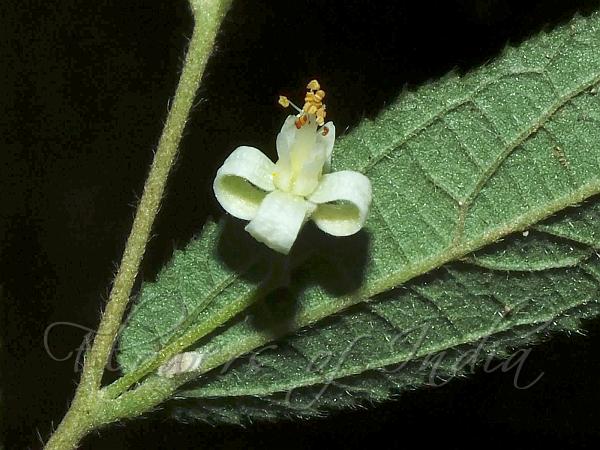|
| Dysentery Bush |
|

|

| File size | 424410 |
| Original date | 8/19/22 2:24 PM |
| Resolution | 4608 x 3456 |
| Flash | Flash fired |
| Focal length | 23.0mm |
| Exposure time | 1/4000s |
| Aperture | 11.0 |
| Focus Distance | 0.0m |
| Metering Mode | Multi-segment |
| Camera make | FUJIFILM |
| Camera model | FinePix HS35EXR |
| Sensor type | OneChipColorArea |
|
|
|
|
Photo: |
Botanical name: Grewia polygama Family: Tiliaceae (Falsa family)
Synonyms: Grewia lancifolia, Grewia polygama var. elliptica
Synonyms: Grewia lancifolia, Grewia polygama var. elliptica
Dysentery Bush is a shrub or small tree up to 5 m tall
with a trunk around 10cm in diameter. Leaves are lanceshaped,
sawtoothed, hairy, 3-nerved from the base, about 10 cm long, 2.5 cm
broad. Flower-cluster-stalks arise in leaf axils, longer than the
flower-stalks. Each cluster has 4-6 white flowers. Petals are oblong
with entire tips, sepals linear twice as long as petals. Stamens are
numerous. In the female flowers, style is longer than the stamens.
Berries are 4-celled, each cell about the size of a small pea. The tree
is harvested from the wild for local use as a medicine, food and source
of wood. Dysentery Bush is native to India, Bangladesh, Cambodia, Laos,
Malaya, Myanmar, Sri Lanka, Thailand, Vietnam.
Medicinal uses: The leaves are soaked in water
overnight, or maybe hot water is poured over them, and the liquid
allowed to become cold. It forms a somewhat mucilaginous liquid and is
said to be very efficacious as a remedy for diarrhoea and dysentery.
The unripe fruit is astringent and can be used in the treatment of
diarrhoea and dysentery. The root is used in the treatment of diarrhoea
and dysentery.
The leaves are soaked in water
overnight, or maybe hot water is poured over them, and the liquid
allowed to become cold. It forms a somewhat mucilaginous liquid and is
said to be very efficacious as a remedy for diarrhoea and dysentery.
The unripe fruit is astringent and can be used in the treatment of
diarrhoea and dysentery. The root is used in the treatment of diarrhoea
and dysentery.
Medicinal uses:
 The leaves are soaked in water
overnight, or maybe hot water is poured over them, and the liquid
allowed to become cold. It forms a somewhat mucilaginous liquid and is
said to be very efficacious as a remedy for diarrhoea and dysentery.
The unripe fruit is astringent and can be used in the treatment of
diarrhoea and dysentery. The root is used in the treatment of diarrhoea
and dysentery.
The leaves are soaked in water
overnight, or maybe hot water is poured over them, and the liquid
allowed to become cold. It forms a somewhat mucilaginous liquid and is
said to be very efficacious as a remedy for diarrhoea and dysentery.
The unripe fruit is astringent and can be used in the treatment of
diarrhoea and dysentery. The root is used in the treatment of diarrhoea
and dysentery. | Identification credit: Kishore Kaycee | Photographed in Yamunanagar, Haryana. |
• Is this flower misidentified? If yes,